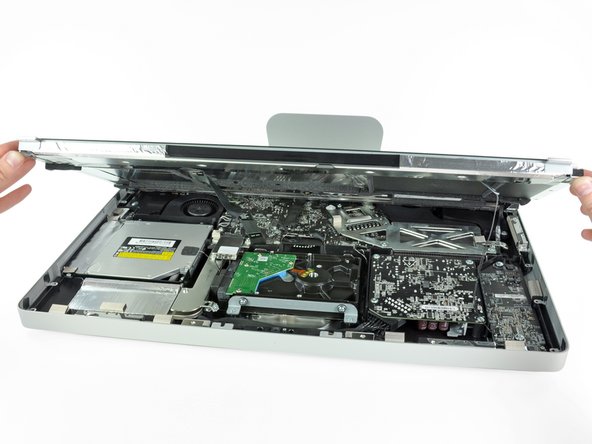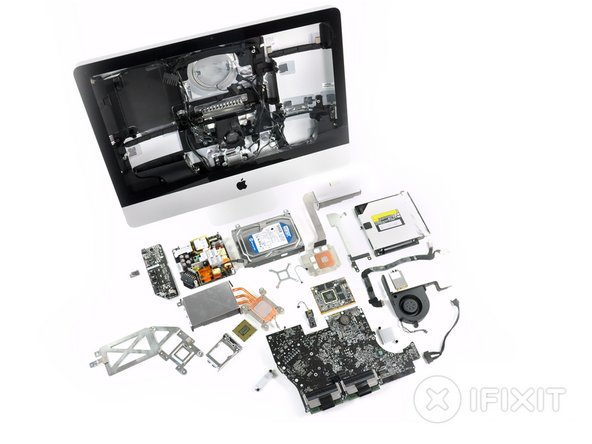
We got up this morning to news that the new iMacs were out, so we knew what we had to do: start sharpening our suction cups!
Our suction cup gamble paid off. We found very soon that this model iMac opens in the same way as previous generations. All you have to do is pull off the magnetically-held display glass with two medium-size suction cups, and then remove the screws holding the LCD in place.
But what lies inside? We knew of only one way to find out…
The 21.5″ iMac (EMC 2428) scored a very respectable 7 out of 10 Repairability Score. Most of the disassembly is pretty straightforward and accomplished using a T10 Torx screwdriver and suction cups. A casual user can easily replace the RAM, and it’s moderately difficult to access the hard drive and optical drive.
However, more adventurous users (those wanting to upgrade the CPU/GPU) will have to take out the logic board, which is a tricky process; they will also have to void the warranty if they replace the CPU. It’s also quite difficult to reassemble the LCD and glass without a dust mite getting stuck in between the two.
Teardown highlights:
- The LED display is manufactured by LG and is denoted by its model number LM215WF3. This is the same display used in the previous generation 21.5″ iMac.
- Similar (but not exactly the same) to the Thunderbolt IC we found in the latest MacBook Pro 15″, the iMac features the Intel L102IA84 EFL Thunderbolt port IC.
- The optional SSD appears to reside beneath the optical drive — that’s the only space we could find where something was clearly missing. There’s three mounting points under the optical drive that have nothing attached to them in our machine, since this option is only available on 2.7 GHz 21.5″ iMacs.
- If you want to remove the logic board, you have to snake it out from the rest of the iMac — a combination of pulling up, as well as away from the casing. After a little bit of jiggling, it comes right out.
- In usual Apple fashion, one heat sink is reserved for the CPU, while the other oversees the GPU. And, in usual Apple fashion, you have to void the warranty in order to get a peep at the CPU processing power underneath.
- Of course, we’ll do almost anything in the name of science.
- After popping off the CPU heat sink, we can get a good look at the Core i5 processor. Our machine is powered by a quad-core 2.5 GHz Core i5-2800S CPU with 6 MB of Intel Smart Cache.
- With a bit of magic, the GPU heat sink detaches from the logic board, exposing the AMD GPU board. You heard that right, folks — you don’t have to replace the entire logic board if your GPU explodes from too much l33t gaming. You can just swap out the GPU board for another one.
- The main chips on the GPU board include the AMD Radeon HD 6750M GPU, as well as four Hynix H5GQ1H24AFR T2L 1 Gb GDDR SDRAM chips (totaling a cumulative 512 MB).
- Thankfully, both the CPU and GPU on this machine have proper amounts of thermal paste applied, a happy departure from the gobs applied to the MacBook Pro we recently took apart.
- At the heart of the Bluetooth board lies a Broadcom BCM2046 Bluetooth IC, as well as 256 KB of SST 39VF200A CMOS Multi-Purpose Flash (MPF). We found this same Broadcom chip a long time ago in the first MacBook Air. If it ain’t broke, why fix it?
- Key players on the logic board include:
- 2.5 GHz quad-core Intel Core i5-2800S CPU with 6 MB of Intel Smart Cache.
- Intel BD82Z68 Platform Controller Hub
- Broadcom BCM57765B0KMLG Integrated Gigabit Ethernet and Memory Card Reader Controller
- Cirrus 4206BCNZ audio controller
- SMSC USX2061 (we believe this a USB 2.0 Hub Controller Family)
- Intersil ISL6364 CRZ Single-Phase Synchronous-Buck PWM voltage regulator for GPU core power applications
- Intel L102IA84 EFL Thunderbolt port IC






0 opmerkingen